Business Analysis of Texaco Inc. using Porter's Five Forces Framework
VerifiedAdded on 2020/06/05
|9
|2545
|47
Report
AI Summary
This report provides a comprehensive business analysis of Texaco Inc., focusing on the application of Porter's Five Forces framework. The introduction establishes the importance of business operations and customer satisfaction. Task 1 delves into the Porter's Five Forces model, examining the threats of new entrants, substitutes, bargaining power of customers and suppliers, and industry rivalry within the context of Texaco's market position. The report highlights key factors influencing these forces, such as barriers to entry, customer loyalty, and the availability of substitute products. It also explores the importance of supply chain management, pricing strategies, brand value, marketing, and human resources within Texaco's business model. The analysis aims to identify opportunities for innovation and strategic improvements to enhance productivity, profitability, and competitive advantage within the oil industry. The conclusion summarizes the key findings and implications of the analysis for Texaco's business strategy.
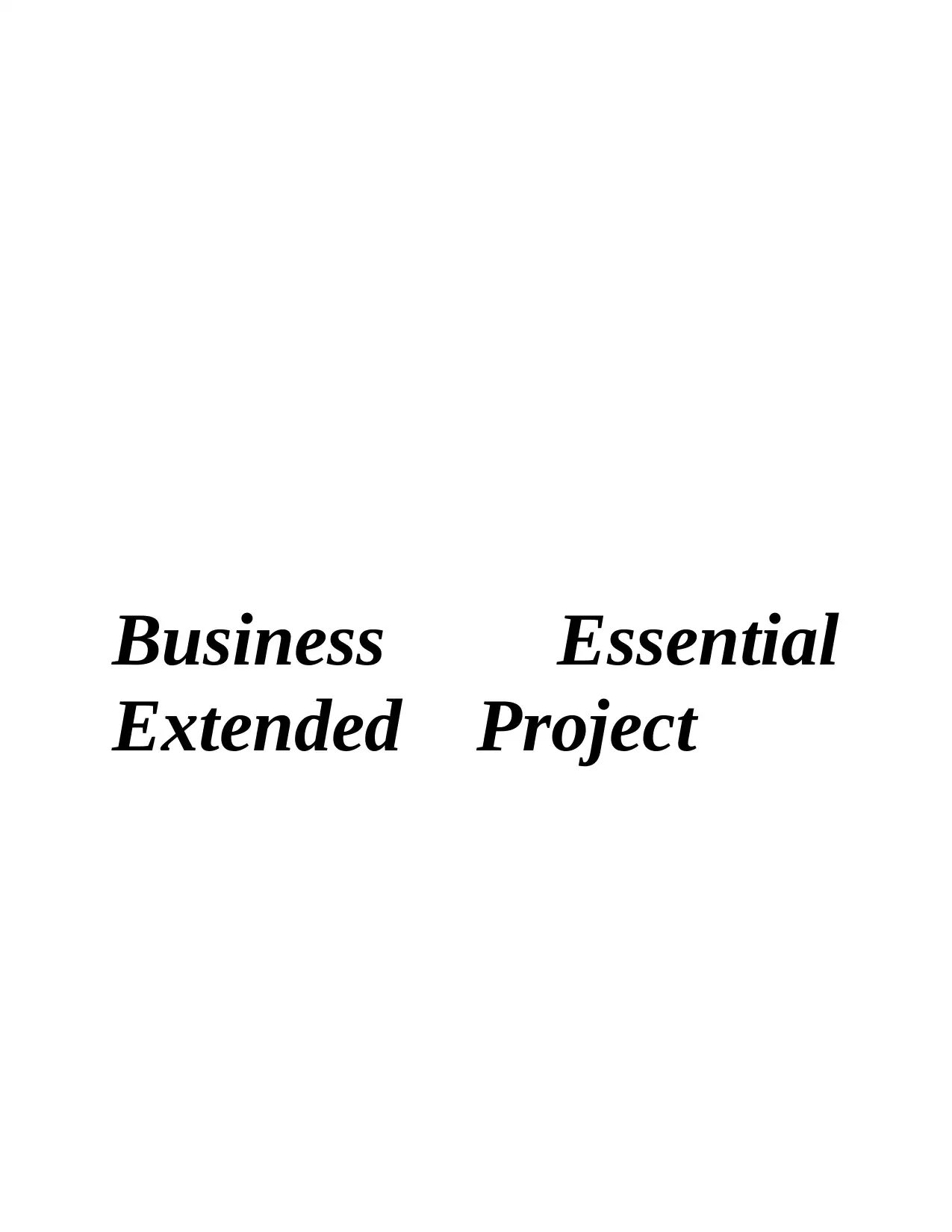
Business Essential
Extended Project
Extended Project
Paraphrase This Document
Need a fresh take? Get an instant paraphrase of this document with our AI Paraphraser
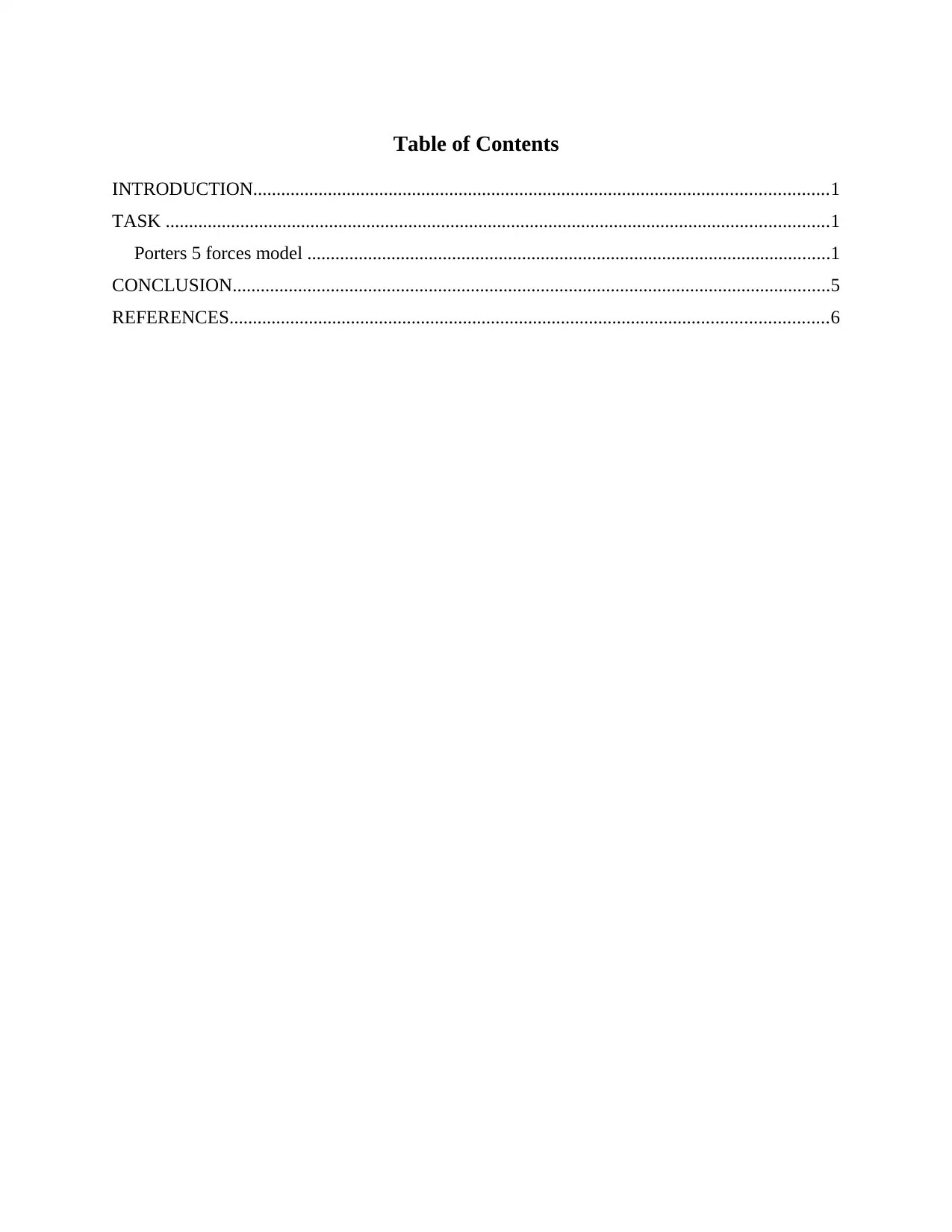
Table of Contents
INTRODUCTION...........................................................................................................................1
TASK ..............................................................................................................................................1
Porters 5 forces model ................................................................................................................1
CONCLUSION................................................................................................................................5
REFERENCES................................................................................................................................6
INTRODUCTION...........................................................................................................................1
TASK ..............................................................................................................................................1
Porters 5 forces model ................................................................................................................1
CONCLUSION................................................................................................................................5
REFERENCES................................................................................................................................6
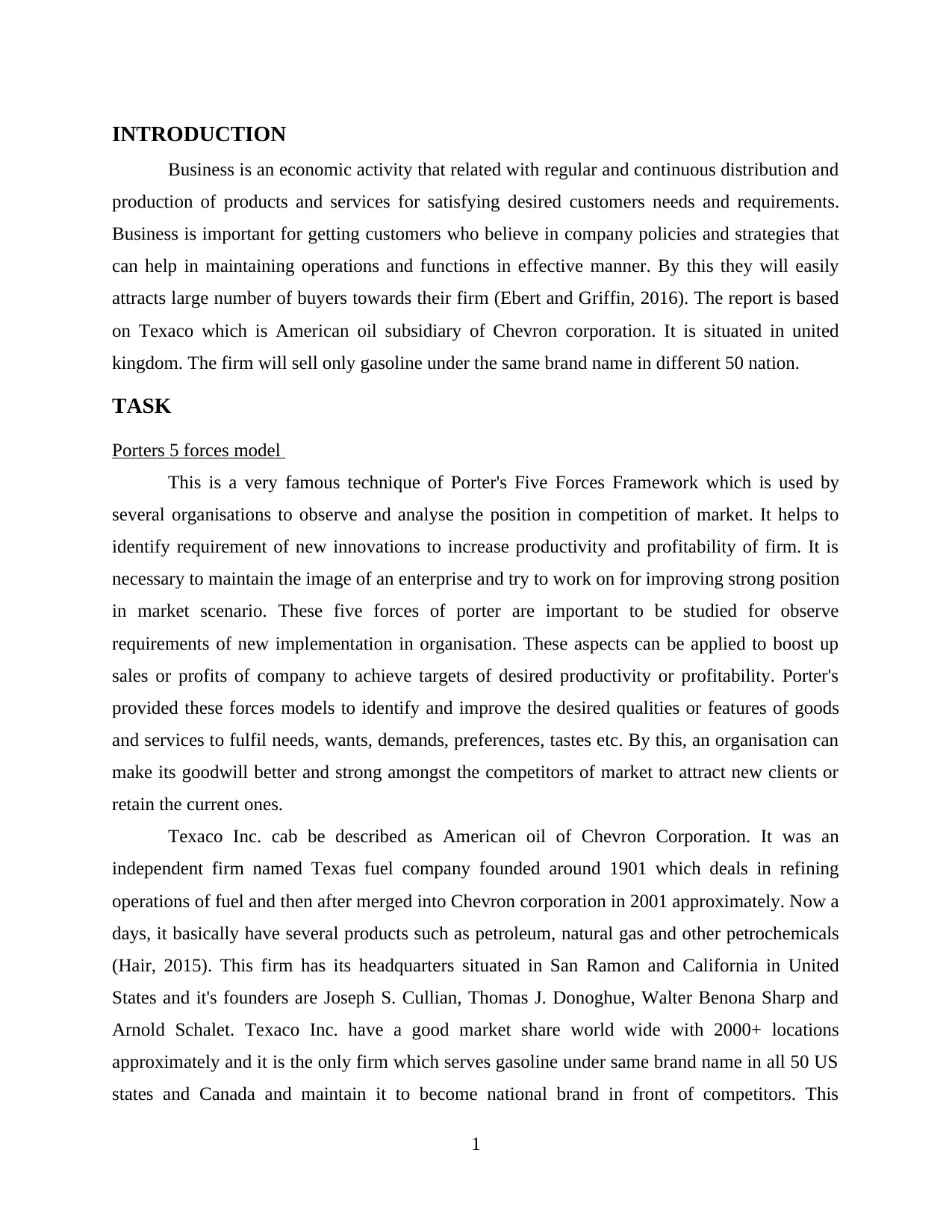
INTRODUCTION
Business is an economic activity that related with regular and continuous distribution and
production of products and services for satisfying desired customers needs and requirements.
Business is important for getting customers who believe in company policies and strategies that
can help in maintaining operations and functions in effective manner. By this they will easily
attracts large number of buyers towards their firm (Ebert and Griffin, 2016). The report is based
on Texaco which is American oil subsidiary of Chevron corporation. It is situated in united
kingdom. The firm will sell only gasoline under the same brand name in different 50 nation.
TASK
Porters 5 forces model
This is a very famous technique of Porter's Five Forces Framework which is used by
several organisations to observe and analyse the position in competition of market. It helps to
identify requirement of new innovations to increase productivity and profitability of firm. It is
necessary to maintain the image of an enterprise and try to work on for improving strong position
in market scenario. These five forces of porter are important to be studied for observe
requirements of new implementation in organisation. These aspects can be applied to boost up
sales or profits of company to achieve targets of desired productivity or profitability. Porter's
provided these forces models to identify and improve the desired qualities or features of goods
and services to fulfil needs, wants, demands, preferences, tastes etc. By this, an organisation can
make its goodwill better and strong amongst the competitors of market to attract new clients or
retain the current ones.
Texaco Inc. cab be described as American oil of Chevron Corporation. It was an
independent firm named Texas fuel company founded around 1901 which deals in refining
operations of fuel and then after merged into Chevron corporation in 2001 approximately. Now a
days, it basically have several products such as petroleum, natural gas and other petrochemicals
(Hair, 2015). This firm has its headquarters situated in San Ramon and California in United
States and it's founders are Joseph S. Cullian, Thomas J. Donoghue, Walter Benona Sharp and
Arnold Schalet. Texaco Inc. have a good market share world wide with 2000+ locations
approximately and it is the only firm which serves gasoline under same brand name in all 50 US
states and Canada and maintain it to become national brand in front of competitors. This
1
Business is an economic activity that related with regular and continuous distribution and
production of products and services for satisfying desired customers needs and requirements.
Business is important for getting customers who believe in company policies and strategies that
can help in maintaining operations and functions in effective manner. By this they will easily
attracts large number of buyers towards their firm (Ebert and Griffin, 2016). The report is based
on Texaco which is American oil subsidiary of Chevron corporation. It is situated in united
kingdom. The firm will sell only gasoline under the same brand name in different 50 nation.
TASK
Porters 5 forces model
This is a very famous technique of Porter's Five Forces Framework which is used by
several organisations to observe and analyse the position in competition of market. It helps to
identify requirement of new innovations to increase productivity and profitability of firm. It is
necessary to maintain the image of an enterprise and try to work on for improving strong position
in market scenario. These five forces of porter are important to be studied for observe
requirements of new implementation in organisation. These aspects can be applied to boost up
sales or profits of company to achieve targets of desired productivity or profitability. Porter's
provided these forces models to identify and improve the desired qualities or features of goods
and services to fulfil needs, wants, demands, preferences, tastes etc. By this, an organisation can
make its goodwill better and strong amongst the competitors of market to attract new clients or
retain the current ones.
Texaco Inc. cab be described as American oil of Chevron Corporation. It was an
independent firm named Texas fuel company founded around 1901 which deals in refining
operations of fuel and then after merged into Chevron corporation in 2001 approximately. Now a
days, it basically have several products such as petroleum, natural gas and other petrochemicals
(Hair, 2015). This firm has its headquarters situated in San Ramon and California in United
States and it's founders are Joseph S. Cullian, Thomas J. Donoghue, Walter Benona Sharp and
Arnold Schalet. Texaco Inc. have a good market share world wide with 2000+ locations
approximately and it is the only firm which serves gasoline under same brand name in all 50 US
states and Canada and maintain it to become national brand in front of competitors. This
1
⊘ This is a preview!⊘
Do you want full access?
Subscribe today to unlock all pages.

Trusted by 1+ million students worldwide
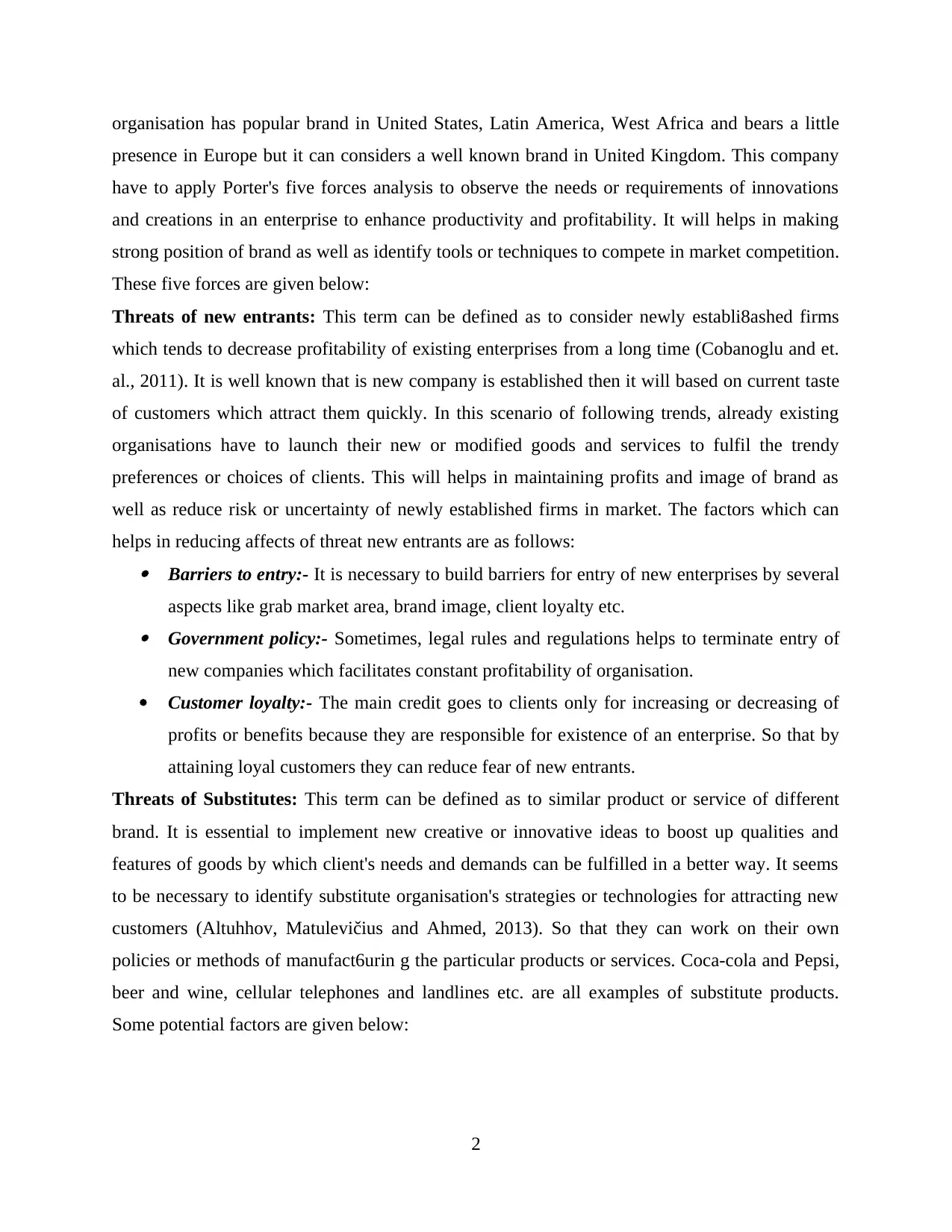
organisation has popular brand in United States, Latin America, West Africa and bears a little
presence in Europe but it can considers a well known brand in United Kingdom. This company
have to apply Porter's five forces analysis to observe the needs or requirements of innovations
and creations in an enterprise to enhance productivity and profitability. It will helps in making
strong position of brand as well as identify tools or techniques to compete in market competition.
These five forces are given below:
Threats of new entrants: This term can be defined as to consider newly establi8ashed firms
which tends to decrease profitability of existing enterprises from a long time (Cobanoglu and et.
al., 2011). It is well known that is new company is established then it will based on current taste
of customers which attract them quickly. In this scenario of following trends, already existing
organisations have to launch their new or modified goods and services to fulfil the trendy
preferences or choices of clients. This will helps in maintaining profits and image of brand as
well as reduce risk or uncertainty of newly established firms in market. The factors which can
helps in reducing affects of threat new entrants are as follows: Barriers to entry:- It is necessary to build barriers for entry of new enterprises by several
aspects like grab market area, brand image, client loyalty etc. Government policy:- Sometimes, legal rules and regulations helps to terminate entry of
new companies which facilitates constant profitability of organisation.
Customer loyalty:- The main credit goes to clients only for increasing or decreasing of
profits or benefits because they are responsible for existence of an enterprise. So that by
attaining loyal customers they can reduce fear of new entrants.
Threats of Substitutes: This term can be defined as to similar product or service of different
brand. It is essential to implement new creative or innovative ideas to boost up qualities and
features of goods by which client's needs and demands can be fulfilled in a better way. It seems
to be necessary to identify substitute organisation's strategies or technologies for attracting new
customers (Altuhhov, Matulevičius and Ahmed, 2013). So that they can work on their own
policies or methods of manufact6urin g the particular products or services. Coca-cola and Pepsi,
beer and wine, cellular telephones and landlines etc. are all examples of substitute products.
Some potential factors are given below:
2
presence in Europe but it can considers a well known brand in United Kingdom. This company
have to apply Porter's five forces analysis to observe the needs or requirements of innovations
and creations in an enterprise to enhance productivity and profitability. It will helps in making
strong position of brand as well as identify tools or techniques to compete in market competition.
These five forces are given below:
Threats of new entrants: This term can be defined as to consider newly establi8ashed firms
which tends to decrease profitability of existing enterprises from a long time (Cobanoglu and et.
al., 2011). It is well known that is new company is established then it will based on current taste
of customers which attract them quickly. In this scenario of following trends, already existing
organisations have to launch their new or modified goods and services to fulfil the trendy
preferences or choices of clients. This will helps in maintaining profits and image of brand as
well as reduce risk or uncertainty of newly established firms in market. The factors which can
helps in reducing affects of threat new entrants are as follows: Barriers to entry:- It is necessary to build barriers for entry of new enterprises by several
aspects like grab market area, brand image, client loyalty etc. Government policy:- Sometimes, legal rules and regulations helps to terminate entry of
new companies which facilitates constant profitability of organisation.
Customer loyalty:- The main credit goes to clients only for increasing or decreasing of
profits or benefits because they are responsible for existence of an enterprise. So that by
attaining loyal customers they can reduce fear of new entrants.
Threats of Substitutes: This term can be defined as to similar product or service of different
brand. It is essential to implement new creative or innovative ideas to boost up qualities and
features of goods by which client's needs and demands can be fulfilled in a better way. It seems
to be necessary to identify substitute organisation's strategies or technologies for attracting new
customers (Altuhhov, Matulevičius and Ahmed, 2013). So that they can work on their own
policies or methods of manufact6urin g the particular products or services. Coca-cola and Pepsi,
beer and wine, cellular telephones and landlines etc. are all examples of substitute products.
Some potential factors are given below:
2
Paraphrase This Document
Need a fresh take? Get an instant paraphrase of this document with our AI Paraphraser
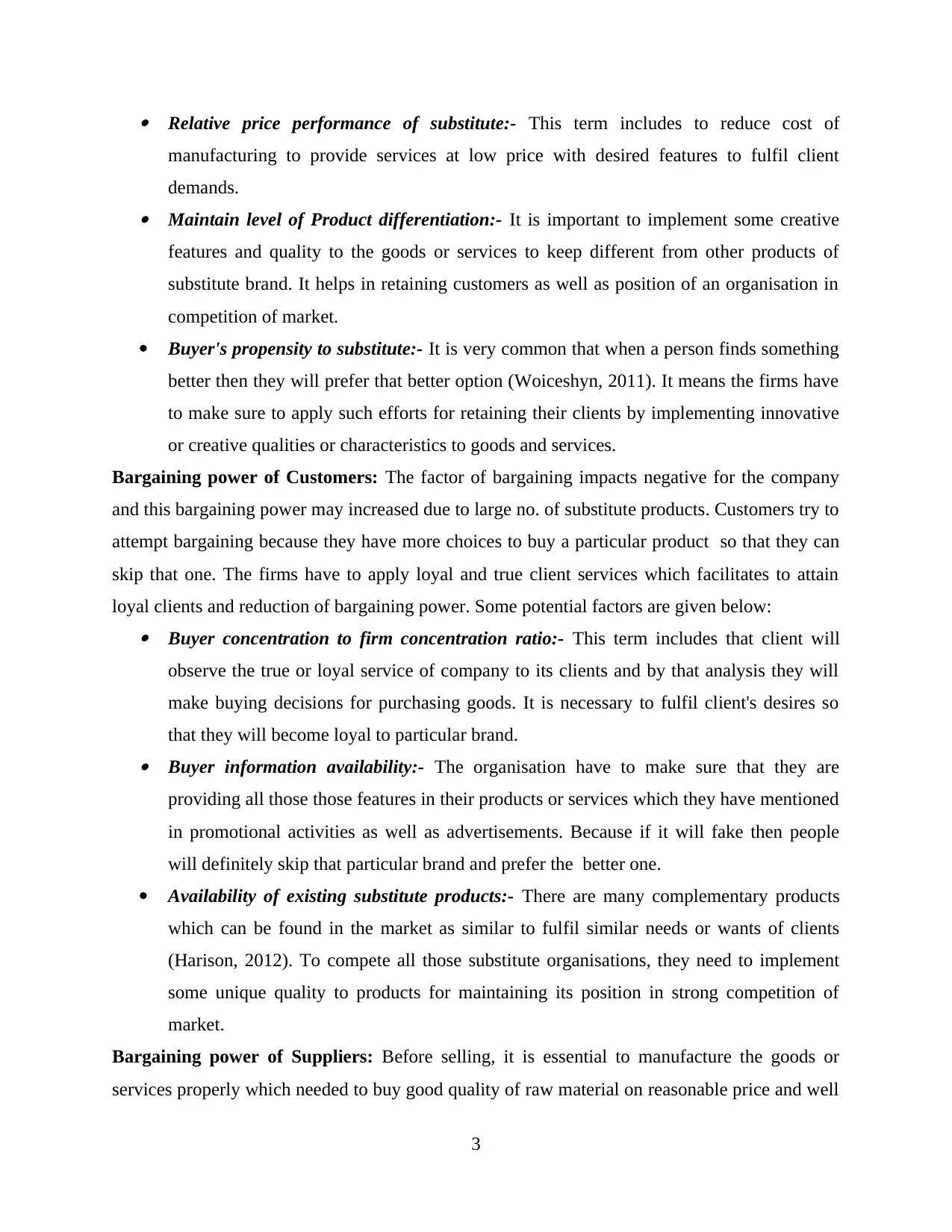
Relative price performance of substitute:- This term includes to reduce cost of
manufacturing to provide services at low price with desired features to fulfil client
demands. Maintain level of Product differentiation:- It is important to implement some creative
features and quality to the goods or services to keep different from other products of
substitute brand. It helps in retaining customers as well as position of an organisation in
competition of market.
Buyer's propensity to substitute:- It is very common that when a person finds something
better then they will prefer that better option (Woiceshyn, 2011). It means the firms have
to make sure to apply such efforts for retaining their clients by implementing innovative
or creative qualities or characteristics to goods and services.
Bargaining power of Customers: The factor of bargaining impacts negative for the company
and this bargaining power may increased due to large no. of substitute products. Customers try to
attempt bargaining because they have more choices to buy a particular product so that they can
skip that one. The firms have to apply loyal and true client services which facilitates to attain
loyal clients and reduction of bargaining power. Some potential factors are given below: Buyer concentration to firm concentration ratio:- This term includes that client will
observe the true or loyal service of company to its clients and by that analysis they will
make buying decisions for purchasing goods. It is necessary to fulfil client's desires so
that they will become loyal to particular brand. Buyer information availability:- The organisation have to make sure that they are
providing all those those features in their products or services which they have mentioned
in promotional activities as well as advertisements. Because if it will fake then people
will definitely skip that particular brand and prefer the better one.
Availability of existing substitute products:- There are many complementary products
which can be found in the market as similar to fulfil similar needs or wants of clients
(Harison, 2012). To compete all those substitute organisations, they need to implement
some unique quality to products for maintaining its position in strong competition of
market.
Bargaining power of Suppliers: Before selling, it is essential to manufacture the goods or
services properly which needed to buy good quality of raw material on reasonable price and well
3
manufacturing to provide services at low price with desired features to fulfil client
demands. Maintain level of Product differentiation:- It is important to implement some creative
features and quality to the goods or services to keep different from other products of
substitute brand. It helps in retaining customers as well as position of an organisation in
competition of market.
Buyer's propensity to substitute:- It is very common that when a person finds something
better then they will prefer that better option (Woiceshyn, 2011). It means the firms have
to make sure to apply such efforts for retaining their clients by implementing innovative
or creative qualities or characteristics to goods and services.
Bargaining power of Customers: The factor of bargaining impacts negative for the company
and this bargaining power may increased due to large no. of substitute products. Customers try to
attempt bargaining because they have more choices to buy a particular product so that they can
skip that one. The firms have to apply loyal and true client services which facilitates to attain
loyal clients and reduction of bargaining power. Some potential factors are given below: Buyer concentration to firm concentration ratio:- This term includes that client will
observe the true or loyal service of company to its clients and by that analysis they will
make buying decisions for purchasing goods. It is necessary to fulfil client's desires so
that they will become loyal to particular brand. Buyer information availability:- The organisation have to make sure that they are
providing all those those features in their products or services which they have mentioned
in promotional activities as well as advertisements. Because if it will fake then people
will definitely skip that particular brand and prefer the better one.
Availability of existing substitute products:- There are many complementary products
which can be found in the market as similar to fulfil similar needs or wants of clients
(Harison, 2012). To compete all those substitute organisations, they need to implement
some unique quality to products for maintaining its position in strong competition of
market.
Bargaining power of Suppliers: Before selling, it is essential to manufacture the goods or
services properly which needed to buy good quality of raw material on reasonable price and well
3
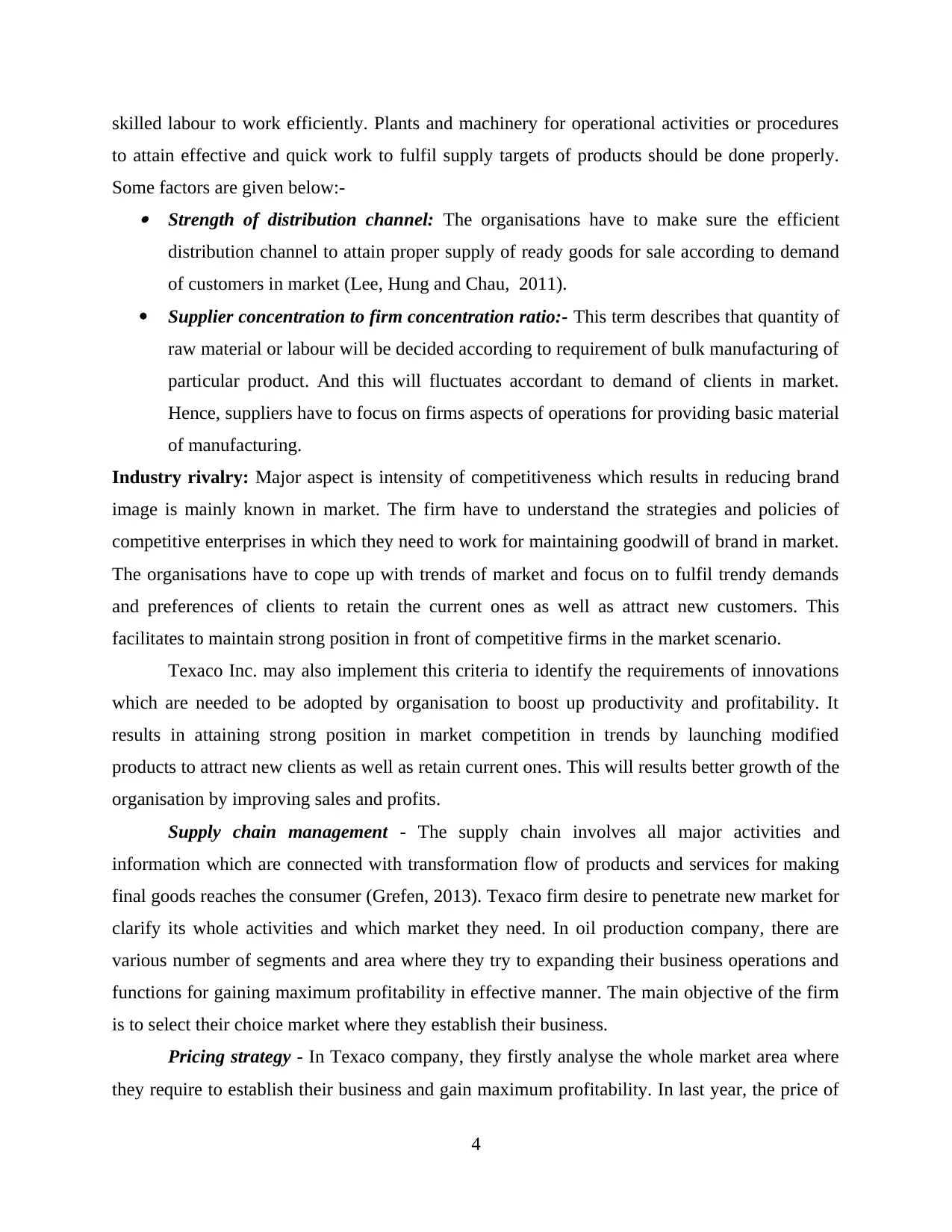
skilled labour to work efficiently. Plants and machinery for operational activities or procedures
to attain effective and quick work to fulfil supply targets of products should be done properly.
Some factors are given below:- Strength of distribution channel: The organisations have to make sure the efficient
distribution channel to attain proper supply of ready goods for sale according to demand
of customers in market (Lee, Hung and Chau, 2011).
Supplier concentration to firm concentration ratio:- This term describes that quantity of
raw material or labour will be decided according to requirement of bulk manufacturing of
particular product. And this will fluctuates accordant to demand of clients in market.
Hence, suppliers have to focus on firms aspects of operations for providing basic material
of manufacturing.
Industry rivalry: Major aspect is intensity of competitiveness which results in reducing brand
image is mainly known in market. The firm have to understand the strategies and policies of
competitive enterprises in which they need to work for maintaining goodwill of brand in market.
The organisations have to cope up with trends of market and focus on to fulfil trendy demands
and preferences of clients to retain the current ones as well as attract new customers. This
facilitates to maintain strong position in front of competitive firms in the market scenario.
Texaco Inc. may also implement this criteria to identify the requirements of innovations
which are needed to be adopted by organisation to boost up productivity and profitability. It
results in attaining strong position in market competition in trends by launching modified
products to attract new clients as well as retain current ones. This will results better growth of the
organisation by improving sales and profits.
Supply chain management - The supply chain involves all major activities and
information which are connected with transformation flow of products and services for making
final goods reaches the consumer (Grefen, 2013). Texaco firm desire to penetrate new market for
clarify its whole activities and which market they need. In oil production company, there are
various number of segments and area where they try to expanding their business operations and
functions for gaining maximum profitability in effective manner. The main objective of the firm
is to select their choice market where they establish their business.
Pricing strategy - In Texaco company, they firstly analyse the whole market area where
they require to establish their business and gain maximum profitability. In last year, the price of
4
to attain effective and quick work to fulfil supply targets of products should be done properly.
Some factors are given below:- Strength of distribution channel: The organisations have to make sure the efficient
distribution channel to attain proper supply of ready goods for sale according to demand
of customers in market (Lee, Hung and Chau, 2011).
Supplier concentration to firm concentration ratio:- This term describes that quantity of
raw material or labour will be decided according to requirement of bulk manufacturing of
particular product. And this will fluctuates accordant to demand of clients in market.
Hence, suppliers have to focus on firms aspects of operations for providing basic material
of manufacturing.
Industry rivalry: Major aspect is intensity of competitiveness which results in reducing brand
image is mainly known in market. The firm have to understand the strategies and policies of
competitive enterprises in which they need to work for maintaining goodwill of brand in market.
The organisations have to cope up with trends of market and focus on to fulfil trendy demands
and preferences of clients to retain the current ones as well as attract new customers. This
facilitates to maintain strong position in front of competitive firms in the market scenario.
Texaco Inc. may also implement this criteria to identify the requirements of innovations
which are needed to be adopted by organisation to boost up productivity and profitability. It
results in attaining strong position in market competition in trends by launching modified
products to attract new clients as well as retain current ones. This will results better growth of the
organisation by improving sales and profits.
Supply chain management - The supply chain involves all major activities and
information which are connected with transformation flow of products and services for making
final goods reaches the consumer (Grefen, 2013). Texaco firm desire to penetrate new market for
clarify its whole activities and which market they need. In oil production company, there are
various number of segments and area where they try to expanding their business operations and
functions for gaining maximum profitability in effective manner. The main objective of the firm
is to select their choice market where they establish their business.
Pricing strategy - In Texaco company, they firstly analyse the whole market area where
they require to establish their business and gain maximum profitability. In last year, the price of
4
⊘ This is a preview!⊘
Do you want full access?
Subscribe today to unlock all pages.

Trusted by 1+ million students worldwide

oil per barrel has low to $27 and after that recovered it around $50. the price of oil and gas
always fluctuating in short time period, so it will became high situation for creating complex
strategy which make boundary and contain growth of profit. The market should impact prices for
making accurate decisions at the time of maintaining pricing strategy in proper manner. By using
this method, the company can survive in the huge competitive market area.
Brand value - Every company has its own brand name which make strong image within
the market place. The major part of oil sector business and brand value should be created in their
upstream business that includes extraction, exploration, trading, wholesale and refining. The
brand element is important for making positive working environment for their employees in
effective manner. Brand value is that process which is used in the marketing sector that can
explains the value of products and services in the large market place (Porters Five Force Model.
2017). A brand name can easily generate large income and revenue in the form of brand
identification, which can form products for making effective brand name and gaining attention of
more number of customers towards specific goods and services.
Marketing - Marketing is that process of management the relationship between seller and
buyer in the large market place. This is used for creating, satisfying and developing the buyers
for maximise profitability. Marketing activity can create greater awareness regarding firm
products and services and engaged sales experts for educate and connected with final buyers
easily. It can help in attracting and gaining customers attention for purchasing desired goods and
services and make strong brand identification.
Human resource - It is the process which binds the people within an organisation and it
help staff members for achieving desired goals and targets in effective manner. In Texaco
company manager can manage and control all business activities and functions for smoothly run
the management. They are design and make various policies and practices which help employees
for reaching the set targets. Company manager mainly responsible for dealing with internal and
external issues which occurs within an organisation. They face various competitor challenges
which are make similar type of products and serve to their dealers and to the final consumers.
CONCLUSION
As per the above mentioned report it can be concluded that Business is an economic
activity that related with regular and continuous distribution and production of products and
services for satisfying desired customers needs and requirements. Texaco firm desire to penetrate
5
always fluctuating in short time period, so it will became high situation for creating complex
strategy which make boundary and contain growth of profit. The market should impact prices for
making accurate decisions at the time of maintaining pricing strategy in proper manner. By using
this method, the company can survive in the huge competitive market area.
Brand value - Every company has its own brand name which make strong image within
the market place. The major part of oil sector business and brand value should be created in their
upstream business that includes extraction, exploration, trading, wholesale and refining. The
brand element is important for making positive working environment for their employees in
effective manner. Brand value is that process which is used in the marketing sector that can
explains the value of products and services in the large market place (Porters Five Force Model.
2017). A brand name can easily generate large income and revenue in the form of brand
identification, which can form products for making effective brand name and gaining attention of
more number of customers towards specific goods and services.
Marketing - Marketing is that process of management the relationship between seller and
buyer in the large market place. This is used for creating, satisfying and developing the buyers
for maximise profitability. Marketing activity can create greater awareness regarding firm
products and services and engaged sales experts for educate and connected with final buyers
easily. It can help in attracting and gaining customers attention for purchasing desired goods and
services and make strong brand identification.
Human resource - It is the process which binds the people within an organisation and it
help staff members for achieving desired goals and targets in effective manner. In Texaco
company manager can manage and control all business activities and functions for smoothly run
the management. They are design and make various policies and practices which help employees
for reaching the set targets. Company manager mainly responsible for dealing with internal and
external issues which occurs within an organisation. They face various competitor challenges
which are make similar type of products and serve to their dealers and to the final consumers.
CONCLUSION
As per the above mentioned report it can be concluded that Business is an economic
activity that related with regular and continuous distribution and production of products and
services for satisfying desired customers needs and requirements. Texaco firm desire to penetrate
5
Paraphrase This Document
Need a fresh take? Get an instant paraphrase of this document with our AI Paraphraser
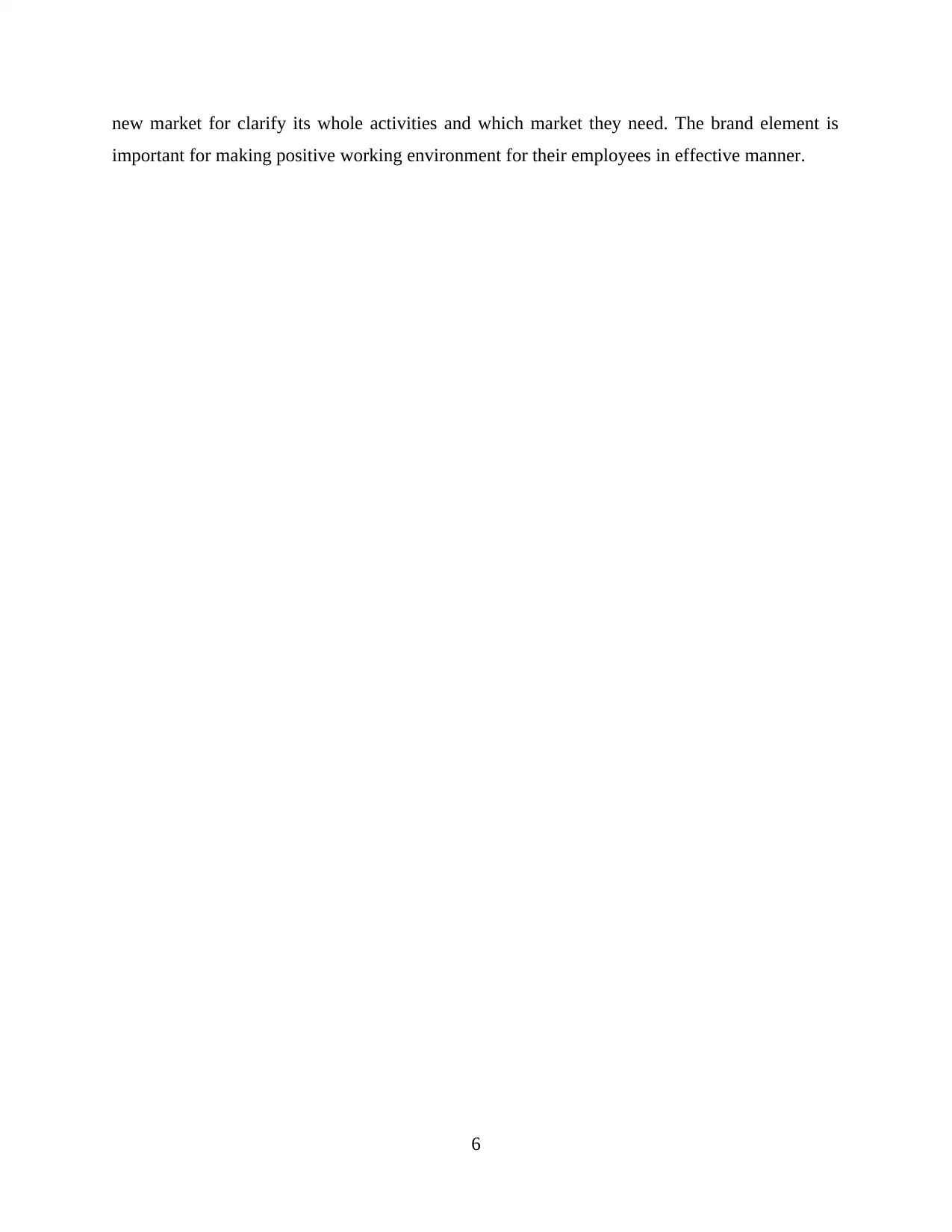
new market for clarify its whole activities and which market they need. The brand element is
important for making positive working environment for their employees in effective manner.
6
important for making positive working environment for their employees in effective manner.
6
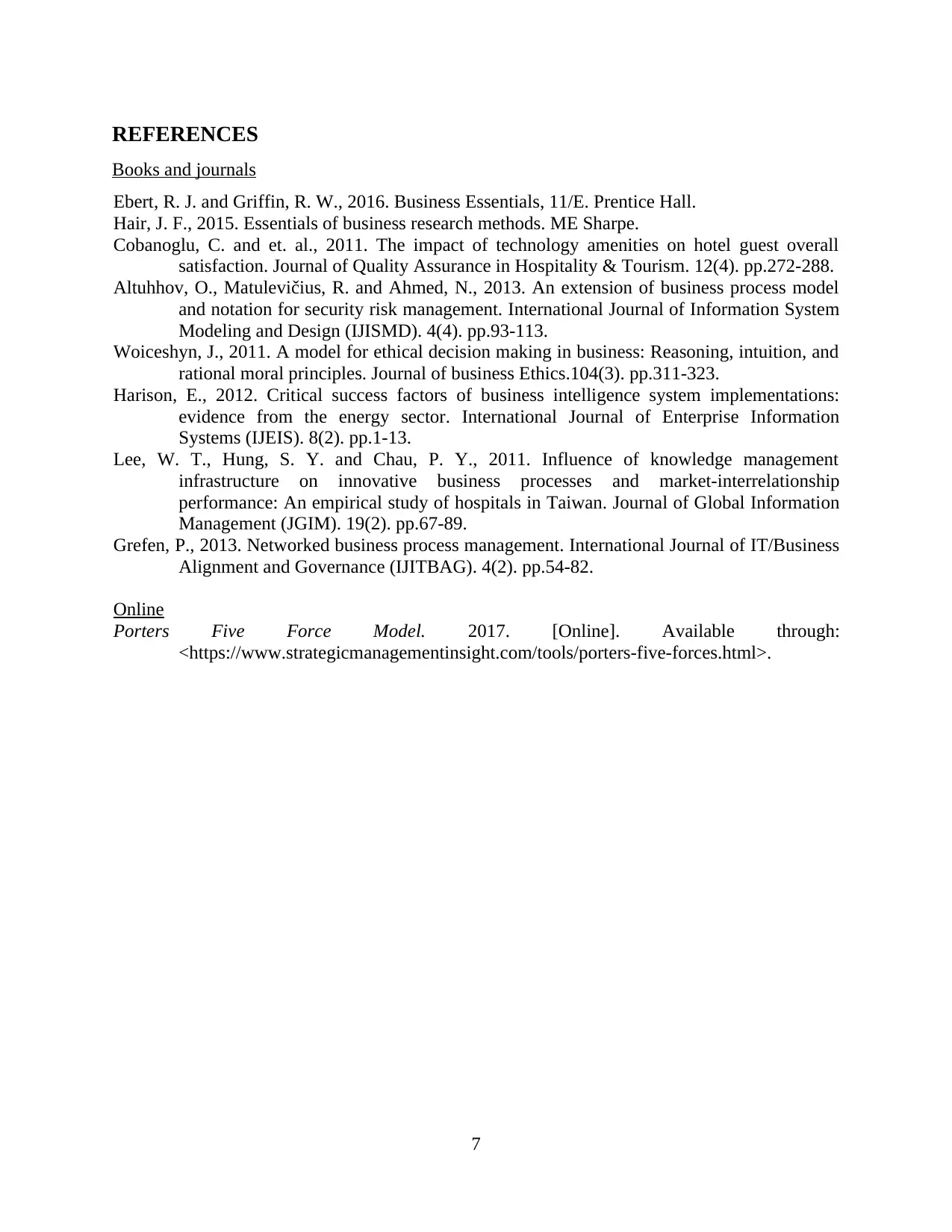
REFERENCES
Books and journals
Ebert, R. J. and Griffin, R. W., 2016. Business Essentials, 11/E. Prentice Hall.
Hair, J. F., 2015. Essentials of business research methods. ME Sharpe.
Cobanoglu, C. and et. al., 2011. The impact of technology amenities on hotel guest overall
satisfaction. Journal of Quality Assurance in Hospitality & Tourism. 12(4). pp.272-288.
Altuhhov, O., Matulevičius, R. and Ahmed, N., 2013. An extension of business process model
and notation for security risk management. International Journal of Information System
Modeling and Design (IJISMD). 4(4). pp.93-113.
Woiceshyn, J., 2011. A model for ethical decision making in business: Reasoning, intuition, and
rational moral principles. Journal of business Ethics.104(3). pp.311-323.
Harison, E., 2012. Critical success factors of business intelligence system implementations:
evidence from the energy sector. International Journal of Enterprise Information
Systems (IJEIS). 8(2). pp.1-13.
Lee, W. T., Hung, S. Y. and Chau, P. Y., 2011. Influence of knowledge management
infrastructure on innovative business processes and market-interrelationship
performance: An empirical study of hospitals in Taiwan. Journal of Global Information
Management (JGIM). 19(2). pp.67-89.
Grefen, P., 2013. Networked business process management. International Journal of IT/Business
Alignment and Governance (IJITBAG). 4(2). pp.54-82.
Online
Porters Five Force Model. 2017. [Online]. Available through:
<https://www.strategicmanagementinsight.com/tools/porters-five-forces.html>.
7
Books and journals
Ebert, R. J. and Griffin, R. W., 2016. Business Essentials, 11/E. Prentice Hall.
Hair, J. F., 2015. Essentials of business research methods. ME Sharpe.
Cobanoglu, C. and et. al., 2011. The impact of technology amenities on hotel guest overall
satisfaction. Journal of Quality Assurance in Hospitality & Tourism. 12(4). pp.272-288.
Altuhhov, O., Matulevičius, R. and Ahmed, N., 2013. An extension of business process model
and notation for security risk management. International Journal of Information System
Modeling and Design (IJISMD). 4(4). pp.93-113.
Woiceshyn, J., 2011. A model for ethical decision making in business: Reasoning, intuition, and
rational moral principles. Journal of business Ethics.104(3). pp.311-323.
Harison, E., 2012. Critical success factors of business intelligence system implementations:
evidence from the energy sector. International Journal of Enterprise Information
Systems (IJEIS). 8(2). pp.1-13.
Lee, W. T., Hung, S. Y. and Chau, P. Y., 2011. Influence of knowledge management
infrastructure on innovative business processes and market-interrelationship
performance: An empirical study of hospitals in Taiwan. Journal of Global Information
Management (JGIM). 19(2). pp.67-89.
Grefen, P., 2013. Networked business process management. International Journal of IT/Business
Alignment and Governance (IJITBAG). 4(2). pp.54-82.
Online
Porters Five Force Model. 2017. [Online]. Available through:
<https://www.strategicmanagementinsight.com/tools/porters-five-forces.html>.
7
⊘ This is a preview!⊘
Do you want full access?
Subscribe today to unlock all pages.

Trusted by 1+ million students worldwide
1 out of 9
Related Documents
Your All-in-One AI-Powered Toolkit for Academic Success.
+13062052269
info@desklib.com
Available 24*7 on WhatsApp / Email
![[object Object]](/_next/static/media/star-bottom.7253800d.svg)
Unlock your academic potential
Copyright © 2020–2025 A2Z Services. All Rights Reserved. Developed and managed by ZUCOL.





